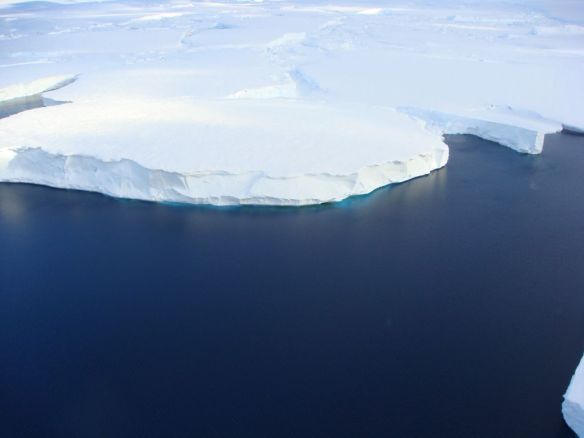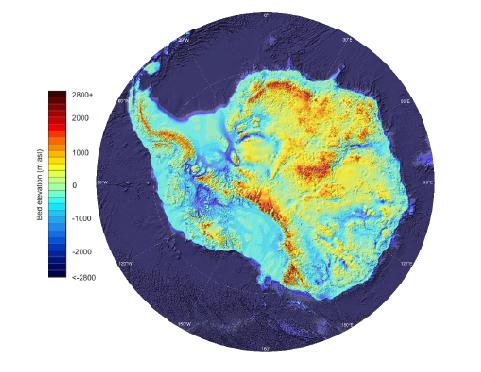The Weddell Polynya is a large hole in the sea ice of the Weddell Sea, near Antarctica. It occurs only very rarely in observations, but is extremely common in ocean models, many of which simulate a near-permanent polynya. My new paper published today in Journal of Climate finds that the Weddell Polynya increases melting beneath the nearby Filchner-Ronne Ice Shelf. This means it’s important to fix the polynya problems in ocean models, if we want to use them to study ice shelves.
The Southern Ocean surrounding Antarctica is cold at the surface – often so cold that it freezes to form sea ice – but warmer below. The deep ocean is about 1°C, which might not sound warm to you, but to Antarctic oceanographers this is positively balmy. If regions of the Southern Ocean start to convect, with strong top-to-bottom mixing, the warm deep water will come to the surface and melt the sea ice.
In observations, this doesn’t happen very often, and it only seems to happen in one region: the Weddell Sea, in the Atlantic sector of the Southern Ocean. Satellites spotted a large polynya (about the size of the UK) for three winters in a row, from 1974-1976. But then the Weddell Polynya disappeared until 2017, when a much smaller polynya (about a tenth of the size) showed up for a few months in the spring. We haven’t seen it since.

The Weddell Polynya in the winter of 1975. (Holland et al., 2001)

The Weddell Polynya in the spring of 2017. (NSIDC)
By contrast, models of the Southern Ocean simulate Weddell Polynyas very enthusiastically. In many ocean models, it’s a near-permanent feature of the Weddell Sea, and is often much larger than the observed polynya from the 1970s. This can happen very easily if the model’s surface waters are slightly too salty, which makes them dense enough to sink, triggering top-to-bottom convection. We also think it might have something to do with imperfect vertical mixing schemes.
It’s a rite of passage for Southern Ocean modellers that sooner or later you will work with a model that forms massive polynyas, all the time, and you can’t make them go away. I spent months and months on this during my PhD, and eventually I gave up and did “surface salinity restoring” to prevent the salty bias from forming. Basically, I killed it with freshwater. If you throw enough freshwater at this problem, the problem will go away.
So when the little Weddell Polynya of 2017 showed up, I was paying attention. And when the worldwide oceanography community jumped on the idea and started publishing lots of papers about the Weddell Polynya, I was paying attention. But soon I noticed that there was an important question nobody was trying to answer: what does the Weddell Polynya mean for Antarctic ice shelves?
Ice shelves are the floating edges of the Antarctic Ice Sheet. They’re in direct contact with the ocean, and they slow down the flow of the glaciers behind them. Ice shelves are what stand between us and massive sea level rise, so we should give them our respect. But ocean modellers have largely neglected them until now, because ice shelf cavities – the pockets of ocean between the ice shelf and the seafloor – are quite difficult to model. This is changing as supercomputers improve and high resolution becomes more affordable. More and more ocean models are adding ice shelf cavities to their simulations, and calculating melt rates at the ice-ocean interface. So if it turns out that the Weddell Polynya contaminates these ice shelf cavities, it would be even more important to fix the models’ polynya biases. It would also be interesting from an observational perspective, especially if the polynya shows up again soon.
At the time I started wondering about the Weddell Polynya and ice shelves, I was conveniently already setting up a new model of the Weddell Sea, which includes ice shelves. This model doesn’t produce Weddell Polynyas spontaneously, and for that I am eternally grateful. But I found a way to create “idealised” polynyas in the model, by choosing particular regions and forcing the model to convect there, whether or not it wanted to. This way I had control over where the polynyas occurred, how large they were, and how long they stayed open. I could run simulations with polynyas, compare them to a simulation with no polynyas, and see how the ice shelf cavities were affected.
I found that Weddell Polynyas do increase melt rates beneath nearby ice shelves. This happens because the polynyas cause density changes in the ocean, which allows more warm, salty deep water to flow onto the Antarctic continental shelf. The melt rates increase the larger the polynya gets, and the longer it stays open. This is bad news for Southern Ocean models with massive, permanent polynyas.
First I looked at the Filchner-Ronne Ice Shelf (FRIS), the second-largest ice shelf in Antarctica, and the focus of my Weddell Sea research these days. On the continental shelf in front of FRIS, the sea ice formation is so strong that the warm signal from the Weddell Polynya gets wiped out. The water ends up at the surface freezing point anyway, and the extra heat is lost to the atmosphere. But the salty signal is still there, and these salinity changes cause the ocean currents beneath FRIS to speed up. Stronger circulation means stronger ice shelf melting, in this case by up to 30% for the largest Weddell Polynyas.
For smaller ice shelves in the Eastern Weddell Sea, the nearby sea ice formation is weaker. So both the warm signal and the salty signal from the Weddell Polynya are preserved, and the ice shelf cavities are flooded with warmer, saltier water. Melting beneath these ice shelves increases by up to 80%.
The modelled changes are smaller for Weddell Polynyas which match observations, in terms of size as well as duration. So if the Weddell Polynya of the 1970s affected the FRIS cavity, it probably wasn’t by very much. And the effect of the little 2017 polynya was probably so small that we’ll never detect it.
However, these results should send a message to Southern Ocean modellers: you really need to fix your polynya problem if you want to model ice shelf cavities. I’m sorry.
















